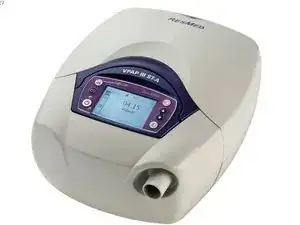VPAP III, VPAP III ST, VPAP III ST-A
Background
VPAP stands for variable positive airway pressure. The word "variable" is used to indicate how the device can vary between two levels of pressure: one exhaling, one for inhaling. The positive pressure is released in a mask that patients must wear anytime they sleep, and helps prevent airway collapse that usually occurs during sleep apnea.
This device is used to treat patients with sleep apnea, as an alternative to existing treatment devices like the CPAP and APAP. When patients do not respond to CPAP and the physician believes it is due to the consistent pressure of the device, he may recommend VPAP to test if the alternating pressures solve the problem. This device may also be used to help patients with sleep apnea that have additional respiratory problems that cannot be solved with a CPAP but do not yet require a APAP. Upper airway resistance syndrome and snoring may also be addressed using this technology.
The VPAP device requires careful adjustment to ensure the pressure of the air flow is at an optimal value. Too low pressure will be ineffective, while too high pressure could result in over-ventilation. The machine will be set by the provider before being distributed to the patient. Health care providers should also ensure the mask fits correctly when placed on the patient. Humidification can be added to combat the dryness that may occur in the sinuses and throat due to this therapy.
Identification
The VPAP III is small and compact, weighing 5.1lbs with dimensions of 10.6"x 9.1"x 5.6."The device is mostly white with a blue button dial. The buttons that regulate both pressures, the on/off button, and the humidity button can all be found on the blue dial. A small screen displays the time, date and air pressure. Near the dial, as part of the body, there is a small plug in for the mask tubing.
Technical Specifications
Weight: 5.1lbs
Size: 10.6"x 9.1"x 5.6."
Sound Pressure: <30dB
Pressure Modes: IPAP, EPAP, CPAP
Respiratory rate: 5-30bpm
Maximum flow capacity: 150-220 L/min
Alarms: mask off alarm, power off alarm, non-vented mask alarm, low minute ventilation alarm, low and high pressure alarm
Rise Time: 150-900 msec
